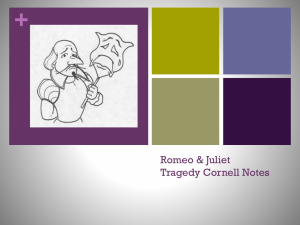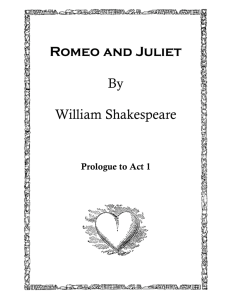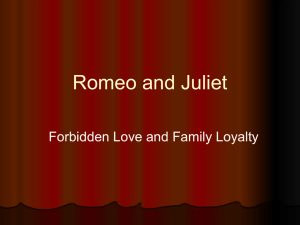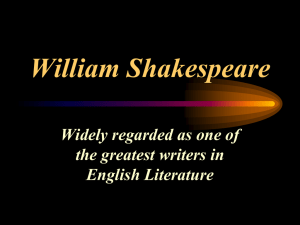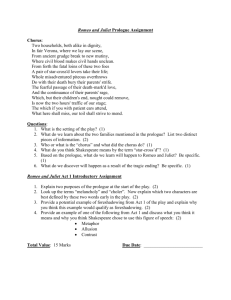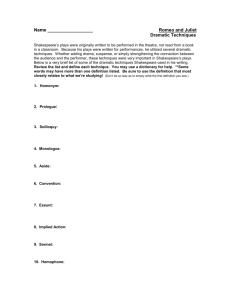Dramatic elements/ analyzing drama
advertisement
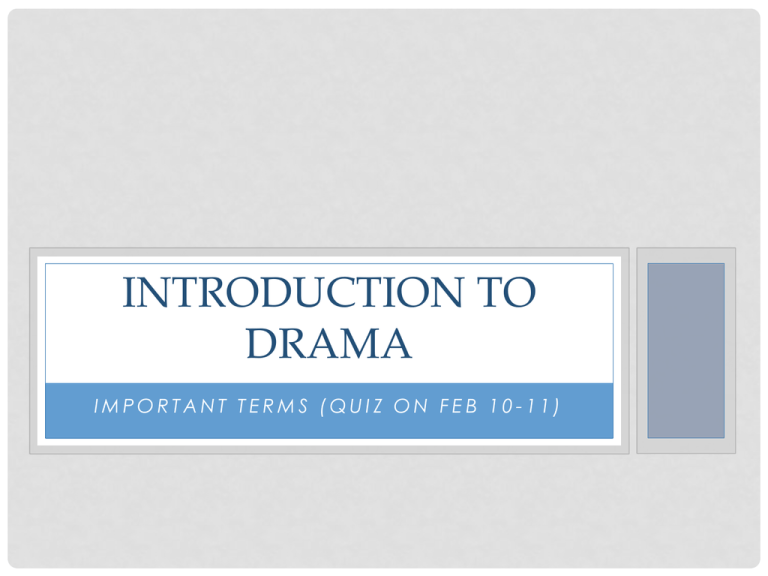
INTRODUCTION TO DRAMA IMPORTANT TERMS (QUIZ ON FEB 10-11) WHAT IS A PLAY? • Play: A story acted out live and onstage • Major types of plays: • Comedy • Tragedy • Modern (mixture of comedy and tragedy, usually) COMEDY • Comedy: a play that ends happily • Characters in Comedy: Central characters can be from any class, including servants. They almost always have flaws, but they usually discover the error of their ways (unlike in tragedies). • Conflicts in Comedy: Conflicts in comedies are almost always romantic in nature—obstacle is always overcome in comedies—obstacles are often ridiculous TRAGEDY • Tragedy: serious and important actions that end unhappily (topics like fate, life, and death) • Tragic Heroes: Central character usually a noble figure who has a personal failing that leads to downfall • Tragic Flaw: Imperfections that lead otherwise noble hero to make choices leading to tragic end (i.e. pride, ambition, passion, jealousy, etc.) DRAMATIC ELEMENTS (CONTINUED) • Script: The text of a play (includes spoken words and stage directions) • Stage Directions: Describe the appearance of the stage, as well as how the characters move and speak on the stage—suggestions rather than demands SCENE 1- DAY 6 Sound of a bicycle bell: DING DING! DING DING! [Lights up on a man and a woman, riding bicycles, side by side, facing the audience. The woman wears a knee brace and rides a road bike; the man rides a mountain bike. They are equipped for a long ride-- helmets, CamelBaks, water bottles, padded bicycle shorts. They've been on these bikes for a while and it shows. They pedal dutifully without interruption. The woman sucks the life out of her water bottle. The man watches her adoringly.] MAN: How’s your knee? WOMAN: I’m thinking it would hurt less if you just wailed on it with a sledgehammer. MAN: Next pit stop we’ll try that instead of ice. WOMAN: Sounds like a plan. Unless you can’t find a sledgehammer. In that case we’ll just go with the ice. MAN: Agreed. (beat) We’re almost there. It’s almost over. In thirty more miles we’ll be there and we’ll be... WOMAN: Done. The longest thirty miles of my life. I’m in misery. (she looks at him) Now would be a good time to make me laugh. MAN: (beat) Marry me. WOMAN: (beat) That’s not funny. Try again. ELEMENTS OF STAGING • Staging: Includes everything that is part of a play but is not part of the written script • Stage: Grand or small in size. In front of the audience or in the center. • Set: Realistic or minimal—transforms stage into setting On the set of Modern Family (TV) STAGES Right: Black Box Left: Thrust Stage Left: Arena Stage Right: Proscenium Stage ELEMENTS OF STAGING • Lighting: Shakespeare’s plays were in outdoor natural lighting—today, most plays are performed indoors and require artificial lighting (including colored lighting) • Costumes and Props: Elaborate or minimal—work with sets and lights to support the action and create the appropriate mood. PLAY PERFORMANCE PERFORMANCE • Plays are meant to be performed • Performance Process Stage Directions Playwright describes setting and actions Interpretation Actors, directors, and designers interpret these directions creatively Performance Audience experiences the story through the actors’ speech and actions SPEAKING • Dialogue: Conversation between characters • Monologue: Long speech by one character to another character/ other characters • Soliloquy: Speech by one character alone onstage to himself/herself or to audience "To Be or Not to Be“ • Aside: A comment only the audience is supposed to hear READING SHAKESPEARE ALOUD • End-stopped Line: Has final punctuation at the end of the line • Run-on Line: Has no final punctuation at the end of the line—NO PAUSE! • Archaic: Used to describe words (or particular meanings of words) that have disappeared from common use (examples: “hap,” “anon,” “mark,” etc.). APPLICATION QUESTIONS Think of a play you have seen (The Odyssey if you went with us!) 1) Describe the stage/set. Was the setting realistic? How? Why or why not? 2) Describe the actors’ costumes. Why do you think they wore these costumes? 3) Evaluate the dialogue. Was it serious or humorous? Clear? Convincing? ANALYSIS: What was the effect of #1-3 on the audience? Paraphrase the words into your own words—to help with this, read No Fear Shakespeare to see how others paraphrase MOVIES AND PLAYS MOVIES VERSUS PLAYS • Plays—long time watching subtle development of conflicts among small group of people in one setting • Movies—visual medium that whisks us from place to place • Delight the eye rather than the ear • Theater is more a medium of words Luhrmann BACKGROUND TO ROMEO AND JULIET Written about 1595 Probably his 13th play Idea taken from “The Tragical History of Romeo and Juliet,” a poem by Arthur Brooke (1562) Unlike his other tragedies, Shakespeare allows chance, or fate, to determine the destiny of the hero and heroine (Romeo and Juliet)—and not necessarily their tragic flaws. PROLOGUE TRANSLATION ACTIVITY (PARAPHRASE) • With a partner, you will paraphrase the prologue of Romeo and Juliet. 1. Read the prologue in Elizabethan English. 2. Decide with your partner what each line would read like in today’s language. Try your best to maintain the specific meaning! 3. Decide on the five most important details. Be prepared to share with the class
